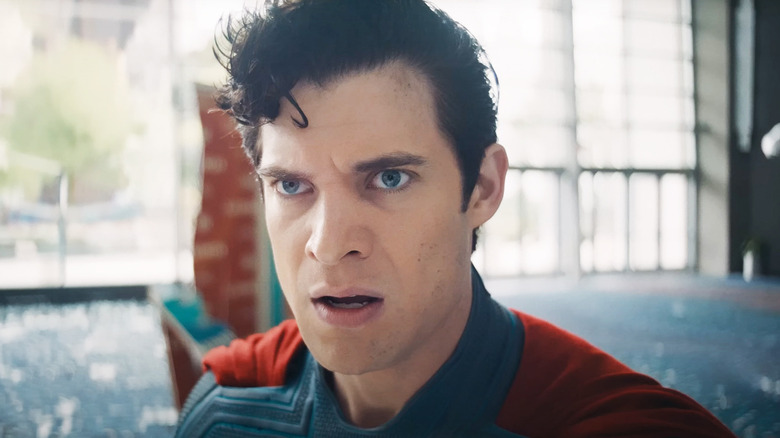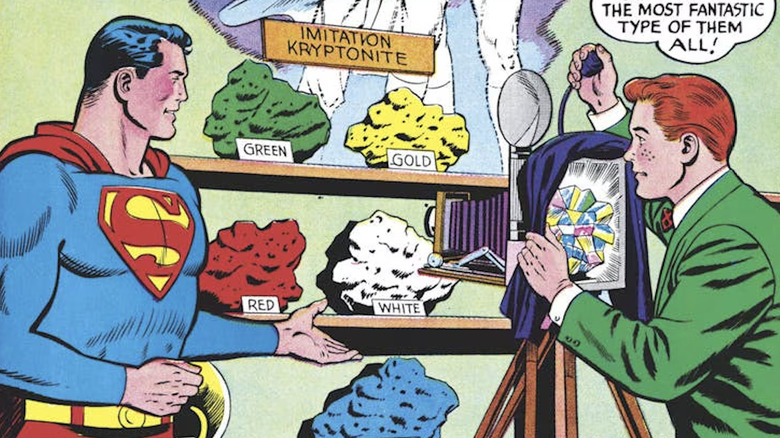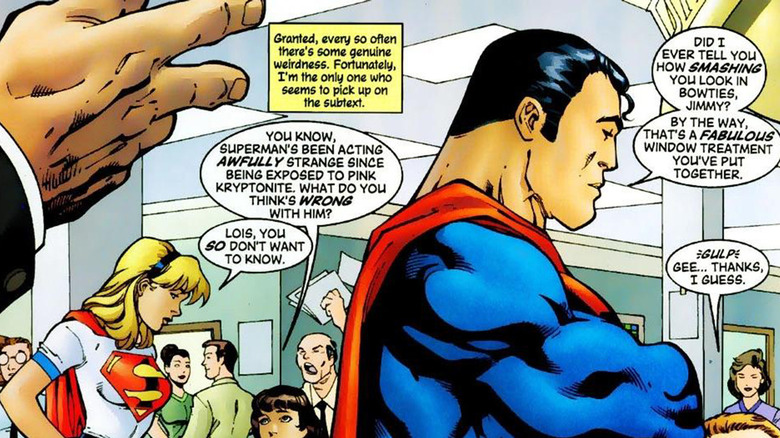James Gunn's DC Universe Will Likely Never Adapt This Offensive Superman Moment
With the silly crowd-pleaser that is "Superman," James Gunn has made superhero movies fun again. Rather, he's made DC fun again after more than a decade of desaturated downers courtesy of the relentlessly lugubrious DC Extended Universe or "Snyderverse." Gunn's Superman differs from past versions in almost every way, with star David Corenswet portraying a sillier, less self-assured version of the hero in a refreshing change of pace for the character and his on-screen odyssey. Now, we can look forward to more of the same as Gunn sets about building upon the foundation provided by "Superman," in the process establishing his vision for the newly renamed DC Universe.
What we almost certainly won't see in future "Superman" installments, however, is a questionable piece of comic book history that, while certainly intended to be as light-hearted as Gunn's latest offering, probably wouldn't go down too well in the modern age. This has to do with the history of Kryptonite, which is far more expansive than you might realize. Throughout the Silver Age of comic books (that is, the 1950s and '60s), writers came up with an astounding number of variations on Superman's achilles' heel, producing multiple different versions of Kryptonite (many of which were just downright silly). This trend somewhat died out in the 1970s, but one writer tried to revive it in the early 2000s — or, rather, he tried to poke fun at the era that saw this grand proliferation of Kryptonite alternatives. Lamentably, this brief parody doesn't actually hold up all that well today, and while Gunn, with his well-publicized love for Silver Age shenanigans, might well want to revisit the history of Kyrptonite variations, focusing on this particular example probably isn't the best idea.
Not all Kryptonite is green
Everybody knows Superman's greatest weakness is Kryptonite. It's one of those foundational pieces of pop culture lore that even non-fans of the DC hero know about. But this ostensibly fundamental piece of Superman mythology actually didn't show up until relatively late in the character's run. The Man of Steel debuted in 1938's "Action Comics" #1, yet Kryptonite wasn't introduced until 1943, and even then, it wasn't in the pages of any comic book. Rather, the powerful crystal debuted in the "Adventures of Superman" radio serial in an episode titled "The Meteor from Krypton." It wouldn't show up in the comics for six more years, and when it did finally appear, it was initially colored red. Only after 1951's "Action Comics" #161 would the stone take on its familiar green hue, with every artist afterwards depicting it this way. Well, when they weren't inventing zany new versions of Kryptonite, anyway.
Depending on the continuity we're talking about, there are actually dozens of different types of Kryptonite. In the era prior to the 1985-86 "Crisis on Infinite Earths" comic book series, the dimension in which Earth One existed contained multiple different forms of the stone, all with different colors and different effects. Most of these were introduced during the Silver Age, a time when more fanciful, outlandish stories were the order of the day. (While Supes was dealing with various forms of Kryptonite, Batman was busy being turned into a "human fish" and doing battle with an "interplanetary rival" known as a "Krajan Cave-Eel.") Throughout this period, we got Gold Kryptonite, which would make Kryptonians unable to process yellow sunlight (essentially turning them into regular humans), while platinum Kryptonite did the opposite, providing humans with Kryptonian super-powers. There was even a Red-Green Kryptonite that caused Superman to grow a third eye on the back of his head.
By 1971, writer Denny O'Neil was done with this Kryptonite obsession and wrote a story that turned every piece of the space rock on Earth into "k-iron," which had no effect whatsoever on Kryptonians. But in the early 2000s, writer Peter David would return to the idea of different Kryptonite types having different effects on Superman, most notably with a questionable storyline that saw the Man of Steel's sexual orientation changed by a pink version of the crystal.
James Gunn will likely avoid pink Kryptonite in his DC Universe
In 2003's "Supergirl" #79, writer Peter David briefly introduced readers to pink Kryptonite. The actual stone itself isn't shown, but it's mentioned by Lois Lane, who comments that "Superman's been acting awfully strange since being exposed to pink Kryptonite." In the same panel, we see Supes chatting to Jimmy Olsen, telling his old pal, "Did I ever tell you how smashing you look in bowties, Jimmy? By the way, that's a fabulous window treatment you've put together." The not so subtle implication is, of course, that pink Kryptonite has turned the Man of Steel gay. This all takes place within a story that depicts Linda Danvers traveling back in time to a Pre-"Crisis" era Earth-One. As such, this panel is clearly a parody of that era's trend of introducing new forms of Kryptonite with ridiculous effects.
Indeed, Reddit users have pointed out as much in a thread called "Weirdest Things in Comics #4: Pink Kryptonite," with commenters highlighting what is an obvious parody of Silver Age excess. One user even notes that the "fabulous window treatment" line appears to be a reference to the 1997 Kevin Klein comedy "In & Out," in which Klein's Howard Brackett attempts to confirm that he is, in fact, heterosexual by listening to an instructional tape on being a "man." At one point, the tape says, "Repeat after me, 'Yo! Hot damn! What a fabulous window treatment!'" before announcing "That was a trick!" The movie was well received at the time and written by Paul Rudnick, who is himself gay. It wouldn't necessarily get a great reception in 2025, but it certainly had some progressive aspects for the mid-'90s, even if it was simply by virtue of depicting a gay man as the lead of a mainstream comedy.
Still, the unavoidable element here is that this apparently gay version of Superman is basically a homosexual stereotype, but given David's otherwise decent record of progressivism, it seems fair to say this was just a creative miscalculation at worst. Interestingly enough, pink Kryptonite would return in the 2017 animated "Justice League Action" short "True Colors," in which it's depicted as switching a Kryptonian's physical sex rather than their orientation.
Despite James Gunn's love for more fantastical comic book stories, none of this is likely to make it into a future "Superman" movie. If anyone knows the pitfalls of revisiting outdated jokes it's Gunn, since he was temporarily fired from "Guardians of the Galaxy Vol. 3" after some of his old offensive joke tweets re-emerged. As such, any kind of pink Kryptonite jokes are probably off the table, which is a good thing — unless Gunn can find a way of making the pink stone into some sort of symbol of empowerment. Perhaps he'll work it into one of his HBO shows, maybe as a throwaway joke for Peacemaker? For now, however, we're just waiting to see if the upcoming "Supergirl" movie will be better than "Superman."


